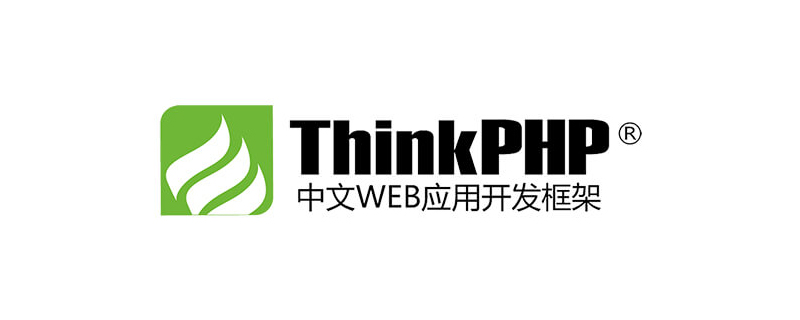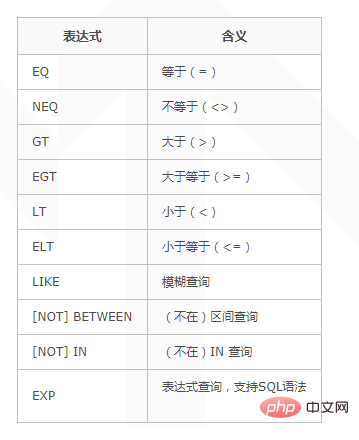How thinkphp queries the database

How does thinkphp query the database?
Database Query
ThinkPHP has built-in very flexible query methods that can quickly perform data query operations.
Query conditions can be used for any operation such as CURD, and can be passed in as parameters of the where method.
ThinkPHP can support the direct use of strings as query conditions, but in most cases it is recommended to use index arrays or objects as query conditions, because it is safer.
Query method
1. Use strings as query conditions
This is the most traditional method, but it is safer Not high, for example:
$User = M("User"); // 实例化User对象
$User->where('type=1 AND status=1')->select();The last generated SQL statement is
SELECT * FROM think_user WHERE type=1 AND status=1
2. Use arrays as query conditions
$User = M("User"); // 实例化User对象
$condition['name'] = 'thinkphp';
$condition['status'] = 1;
// 把查询条件传入查询方法
$User->where($condition)->select();The last generated SQL statement Yes
SELECT * FROM think_user WHERE 'name'='thinkphp' AND status=1
If you perform a multi-field query, the default logical relationship between fields is logical AND, but the default logical judgment can be changed using the following rules, by using _logic to define the query logic:
$User = M("User"); // 实例化User对象
$condition['name'] = 'thinkphp';
$condition['account'] = 'thinkphp';
$condition['_logic'] = 'OR'; //定义查询逻辑
// 把查询条件传入查询方法
$User->where($condition)->select();The final generated SQL statement is
SELECT * FROM think_user WHERE 'name'='thinkphp' OR `account`='thinkphp'
3. Use the object method to query (here, take the stdClass built-in object as an example)
$User = M("User"); // 实例化User对象
// 定义查询条件
$condition = new stdClass();
$condition->name = 'thinkphp';
$condition->status= 1;
$User->where($condition)->select();The final generated SQL statement is the same as above
SELECT * FROM think_user WHERE `name`='thinkphp' AND status=1
The effect of using object mode query and using array query is the same, and they are interchangeable. In most cases, we recommend using array mode to be more efficient. , later we will use the array method as an example to explain the specific query language usage.
Expression query
The above query condition is just a simple equality judgment. Query expressions can be used to support more SQL query syntax and can be used Query in array or object mode (only array mode is used as an example below), the query expression format is:
$map['字段名'] = array('表达式','查询条件');
Expressions are not case-sensitive. The supported query expressions are as follows, respectively. The meaning is:
 ##
##
$map['id'] = array('eq',100); id = 100; $map['id'] = array('egt',100);id >= 100 $map['name'] = array('like','thinkphp%'); name like 'thinkphp%' 模糊查询 $map['a'] =array('like',array('%thinkphp%','%tp'),'OR');$map['b'] =array('notlike',array('%thinkphp%','%tp'),'AND'); (a like '%thinkphp%' OR a like '%tp') AND (b not like '%thinkphp%' AND b not like '%tp')
http://www.php.cn/phpkj/thinkphp /
The above is the detailed content of How thinkphp queries the database. For more information, please follow other related articles on the PHP Chinese website!

Hot AI Tools

Undresser.AI Undress
AI-powered app for creating realistic nude photos

AI Clothes Remover
Online AI tool for removing clothes from photos.

Undress AI Tool
Undress images for free

Clothoff.io
AI clothes remover

Video Face Swap
Swap faces in any video effortlessly with our completely free AI face swap tool!

Hot Article

Hot Tools

Notepad++7.3.1
Easy-to-use and free code editor

SublimeText3 Chinese version
Chinese version, very easy to use

Zend Studio 13.0.1
Powerful PHP integrated development environment

Dreamweaver CS6
Visual web development tools

SublimeText3 Mac version
God-level code editing software (SublimeText3)

Hot Topics
 1387
1387
 52
52
 How to run thinkphp project
Apr 09, 2024 pm 05:33 PM
How to run thinkphp project
Apr 09, 2024 pm 05:33 PM
To run the ThinkPHP project, you need to: install Composer; use Composer to create the project; enter the project directory and execute php bin/console serve; visit http://localhost:8000 to view the welcome page.
 There are several versions of thinkphp
Apr 09, 2024 pm 06:09 PM
There are several versions of thinkphp
Apr 09, 2024 pm 06:09 PM
ThinkPHP has multiple versions designed for different PHP versions. Major versions include 3.2, 5.0, 5.1, and 6.0, while minor versions are used to fix bugs and provide new features. The latest stable version is ThinkPHP 6.0.16. When choosing a version, consider the PHP version, feature requirements, and community support. It is recommended to use the latest stable version for best performance and support.
 How to run thinkphp
Apr 09, 2024 pm 05:39 PM
How to run thinkphp
Apr 09, 2024 pm 05:39 PM
Steps to run ThinkPHP Framework locally: Download and unzip ThinkPHP Framework to a local directory. Create a virtual host (optional) pointing to the ThinkPHP root directory. Configure database connection parameters. Start the web server. Initialize the ThinkPHP application. Access the ThinkPHP application URL and run it.
 Which one is better, laravel or thinkphp?
Apr 09, 2024 pm 03:18 PM
Which one is better, laravel or thinkphp?
Apr 09, 2024 pm 03:18 PM
Performance comparison of Laravel and ThinkPHP frameworks: ThinkPHP generally performs better than Laravel, focusing on optimization and caching. Laravel performs well, but for complex applications, ThinkPHP may be a better fit.
 Development suggestions: How to use the ThinkPHP framework to implement asynchronous tasks
Nov 22, 2023 pm 12:01 PM
Development suggestions: How to use the ThinkPHP framework to implement asynchronous tasks
Nov 22, 2023 pm 12:01 PM
"Development Suggestions: How to Use the ThinkPHP Framework to Implement Asynchronous Tasks" With the rapid development of Internet technology, Web applications have increasingly higher requirements for handling a large number of concurrent requests and complex business logic. In order to improve system performance and user experience, developers often consider using asynchronous tasks to perform some time-consuming operations, such as sending emails, processing file uploads, generating reports, etc. In the field of PHP, the ThinkPHP framework, as a popular development framework, provides some convenient ways to implement asynchronous tasks.
 How to install thinkphp
Apr 09, 2024 pm 05:42 PM
How to install thinkphp
Apr 09, 2024 pm 05:42 PM
ThinkPHP installation steps: Prepare PHP, Composer, and MySQL environments. Create projects using Composer. Install the ThinkPHP framework and dependencies. Configure database connection. Generate application code. Launch the application and visit http://localhost:8000.
 How is the performance of thinkphp?
Apr 09, 2024 pm 05:24 PM
How is the performance of thinkphp?
Apr 09, 2024 pm 05:24 PM
ThinkPHP is a high-performance PHP framework with advantages such as caching mechanism, code optimization, parallel processing and database optimization. Official performance tests show that it can handle more than 10,000 requests per second and is widely used in large-scale websites and enterprise systems such as JD.com and Ctrip in actual applications.
 Development suggestions: How to use the ThinkPHP framework for API development
Nov 22, 2023 pm 05:18 PM
Development suggestions: How to use the ThinkPHP framework for API development
Nov 22, 2023 pm 05:18 PM
Development suggestions: How to use the ThinkPHP framework for API development. With the continuous development of the Internet, the importance of API (Application Programming Interface) has become increasingly prominent. API is a bridge for communication between different applications. It can realize data sharing, function calling and other operations, and provides developers with a relatively simple and fast development method. As an excellent PHP development framework, the ThinkPHP framework is efficient, scalable and easy to use.




